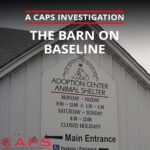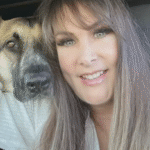Breeder: Walker, Marjorie
Business name: Lin Creek Kennels
Address: PO Box 107
City, State Zip: Gentry, MO 64453
Year: 2004
USDA License: 43-B-0371
USDA Inspector: Rexford Dannull, ACI
USDA Inspections: 2003-02-20
Date of CAPS Investigation: 2004-03-24
See: U.S. Department of Agriculture Decision on Linn Creek Kennel
Breeds: Weimaraners, German Shepherds, Golden Retrievers, Labrador Retrievers, Pit Bulls, Basset Hounds, Australian Shepherds, Beagles, Irish Setters, Great Danes
Single outdoor pens
A pen housing two adult Irish Setters contained a dog house that was not large enough for the dogs to fit in and lie down in a normal manner or turn about freely (3.4(b)-Shelter from the elements). The dog house was lacking a wind/rain break on the entrance (3.4(b)(3)-Shelter from the elements). One of the Setters had several calloused sores on its upper right lip (2.40-Vet care). Another outdoor pen housing two adult Beagles contained a dog house with no wind/rain break on the entrance (3.4(b)(3)-Shelter from the elements).
Row of five pens
Five outdoor pens adjacent to each other and in a row had concrete floorings smeared with several days’ accumulation of fecal matter (3.11(a)-Cleaning of primary enclosures). On the side of the pens with chain link doorways, the concrete floorings extended about a foot beyond the chain link walls; at the far end of the extension, an indentation in the concrete was filled with standing urine and feces (3.1(c)(2)-Maintenance and replacement of surfaces) (3.1(f)-Drainage and waste disposal).
Plastic buckets and bowls on the pen floorings were smeared with feces and had dark brown water in them (3.10-Watering). One of the pens, housing two Weimaraners, had broken, jagged wire near the bottom corner of one of the chain link walls (3.6(a)(2)(i)-Primary enclosures).
Row of four pens
Another set of four outdoor pens, similar to the ones described above, were in a row and adjacent to each other on concrete floorings. Some of these pens were made of thin-gauge, untreated wire (3.6(a)(2)(xii)-Primary enclosures). One wall was rusting 3.6(c)(1)(i)-Housing facilities, general – Surfaces). There was several days’ accumulation of fecal matter in the pens (3.11(a)-Cleaning of primary enclosures). A small concrete ditch outside the pens was filled with standing urine and feces (3.1(c)(2)-Maintenance and replacement of surfaces) (3.1(f)-Drainage and waste disposal).
One pen housed three adult Great Danes. One dog had a concave abdomen and very visible ribs, spine, and hips (2.40-Vet care). The dog houses in the pen were not of sufficient size for any one of the dogs to fit in and lie down in a normal manner or turn about freely (3.4(b)(3)-Shelter from the elements) and lacked wind/rain breaks on the entrances (3.4(b)(3)-Shelter from the elements). Another pen housed three adult Shetland Sheepdogs with thick mats in their fur (2.40-Vet Care.)
Second row of four pens
Another set of four outdoor pens, identical to those described above, were on concrete slabs. Some of the cage walls were made of thin-gauge, untreated wire (3.6(a)(2)(xii)-Primary enclosures). There was several days’ accumulation of fecal matter in each pen (3.11(a)-Cleaning of primary enclosures). A concrete ditch full of standing urine and feces was just outside of the pens (3.1(f)-Drainage and waste disposal). Last row of pens Another series of outdoor pens, made of thin-gauge, untreated wire (3.6(a)(2)(xii)-Primary enclosures), were raised above a concrete flooring. There was more than 24 hours’ accumulation of fecal matter under the cages (3.11(a)-Cleaning of primary enclosures.
Around many of the outdoor pens of this facility, miscellaneous items such as cinder blocks, plastic buckets, a trailer hitch, and tarps were on the ground and within feet of the cages (3.1(b)-Condition and site).




